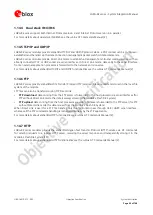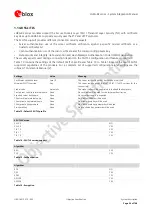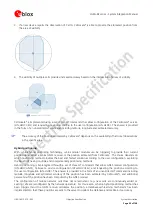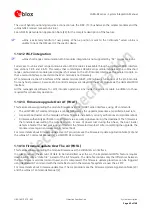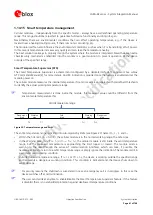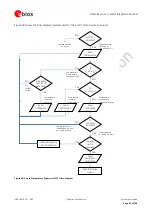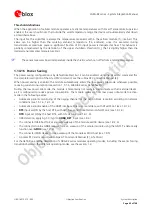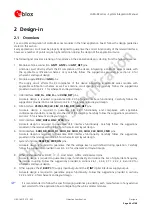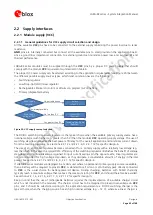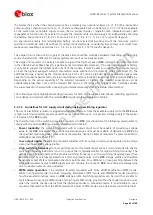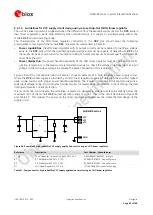
LARA-R2 series - System Integration Manual
UBX-16010573 - R02
Objective Specification
System description
Page 54 of 148
1.14
System features
1.14.1
Network indication
GPIOs can be configured by the AT command to indicate network status (for further details see section 1.12 and
to
u-blox AT Commands Manual
[2], GPIO commands):
No service (no network coverage or not registered)
Registered 2G / LTE home network
Registered 2G / LTE visitor network (roaming)
Call enabled (RF data transmission / reception)
1.14.2
Antenna detection
The antenna detection function provided by the
ANT_DET
pin is based on an ADC measurement as optional
feature that can be implemented if the application requires it. The antenna supervisor is forced by the +UANTR
AT command (see the
u-blox AT Commands Manual
[2] for more details).
The requirements to achieve antenna detection functionality are the following:
an RF antenna assembly with a built-in resistor (diagnostic circuit) must be used
an antenna detection circuit must be implemented on the application board
See section 1.7.2 for detailed antenna detection interface functional description and see section 2.4.2 for
detection circuit on application board and diagnostic circuit on antenna assembly design-in guidelines.
1.14.3
Jamming detection
Congestion detection (i.e. jamming detection) is not supported by “02” product versions.
In real network situations modules can experience various kind of out-of-coverage conditions: limited service
conditions when roaming to networks not supporting the specific SIM, limited service in cells which are not
suitable or barred due to operators’ choices, no cell condition when moving to poorly served or highly interfered
areas. In the latter case, interference can be artificially injected in the environment by a noise generator covering
a given spectrum, thus obscuring the operator’s carriers entitled to give access to the LTE/3G/2G service.
The congestion (i.e. jamming) detection feature can be enabled and configured by the +UCD AT command: the
feature consists of detecting an anomalous source of interference and signaling the start and stop of such
conditions to the host application processor with an unsolicited indication, which can react appropriately by e.g.
switching off the radio transceiver of the module (i.e. configuring the module in “airplane mode” by means of
the +CFUN AT command) in order to reduce power consumption and monitoring the environment at constant
periods (for more details see the
u-blox AT Commands Manual
[2], +UCD AT command).
















